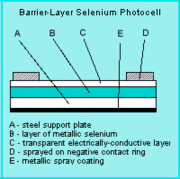Fritts, Charles Edgar
From The Encyclopedia of Earth
August 22, 2008, 3:46 am
Charles Edgar Fritts, an American inventor, built the first genuine solar cell in 1883. His cell used junctions formed by coating the semiconductor, made of selenium, with an ultra thin, nearly transparent layer of gold. Fritts' devices were very inefficient, transforming less than 1 percent of the absorbed light into electrical energy, but they proved the viability of using light as an energy source. Fritts' work helped lay the foundation for subsequent improvements by Ohl and Pearson, and by his colleagues at Bell Labs in the 1950s. Werner von Siemens called Fritts' work as “scientifically of the most far-reaching importance", and his work was thought to influence J.C. Maxwell’s research in quantum mechanics.
